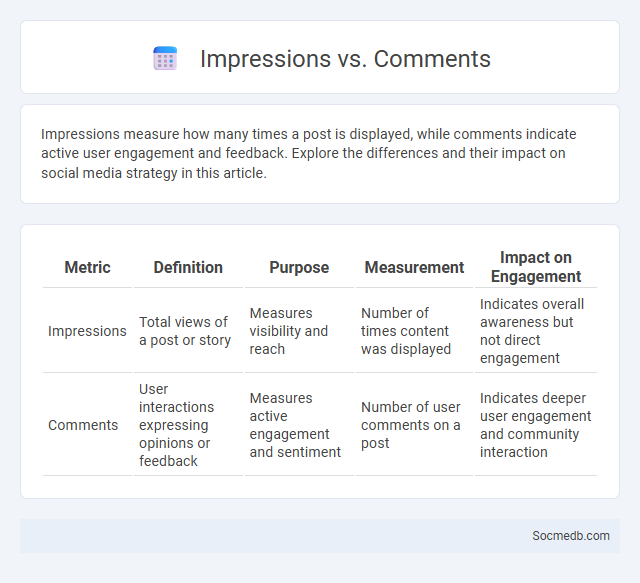
Photo illustration: Impressions vs Comments
Impressions measure how many times a post is displayed, while comments indicate active user engagement and feedback. Explore the differences and their impact on social media strategy in this article.
Table of Comparison
| Metric | Definition | Purpose | Measurement | Impact on Engagement |
|---|---|---|---|---|
| Impressions | Total views of a post or story | Measures visibility and reach | Number of times content was displayed | Indicates overall awareness but not direct engagement |
| Comments | User interactions expressing opinions or feedback | Measures active engagement and sentiment | Number of user comments on a post | Indicates deeper user engagement and community interaction |
Understanding Impressions: Definition and Importance
Impressions on social media represent the total number of times your content is displayed to users, regardless of clicks or engagement, highlighting how often your message reaches your audience. Understanding impressions is crucial for evaluating brand visibility and the potential impact of your marketing efforts across platforms like Facebook, Instagram, and Twitter. Tracking this metric helps you optimize content strategy and increase overall reach.
What Are Comments? Exploring Audience Engagement
Comments are user-generated responses or feedback on social media posts that foster interactive communication between content creators and their audience. They provide valuable insights into audience sentiment, preferences, and reactions, enabling brands to tailor their strategies for improved engagement. Analyzing comment patterns helps identify trends, build community trust, and enhance overall social media performance.
Impressions vs Comments: Key Differences
Impressions measure how many times your social media content is displayed, reflecting overall visibility and reach, whereas comments indicate direct engagement and user interaction with your posts. High impressions suggest a broad audience exposure, but comments provide valuable insights into your audience's sentiments and feedback. Understanding the balance between impressions and comments helps you optimize content strategy to boost both awareness and meaningful conversations.
Why Impressions Matter for Digital Marketers
Impressions are crucial for digital marketers because they measure the total number of times content is displayed to users, indicating potential reach and brand visibility. High impression counts help marketers assess the effectiveness of advertising campaigns and optimize strategies for audience engagement. Tracking impressions allows for better targeting adjustments and increased return on investment (ROI) in social media advertising.
The Role of Comments in Social Media Strategy
Comments play a crucial role in your social media strategy by enhancing engagement and fostering a sense of community around your brand. They provide valuable user feedback, fuel conversations, and increase content visibility through algorithmic boosts. Actively managing and responding to comments helps build trust, encourages return visits, and drives organic growth on platforms like Instagram, Facebook, and LinkedIn.
Measuring Success: Impressions vs Comments
Measuring social media success requires analyzing both impressions and comments to gauge reach and engagement accurately. Impressions indicate how many times content is displayed, reflecting potential audience size, while comments reveal active user interaction and sentiment. Tracking the balance between these metrics helps optimize content strategies for better audience connection and campaign effectiveness.
Boosting Impressions: Proven Strategies
Boosting impressions on social media requires consistent posting of high-quality, engaging content that resonates with Your target audience. Utilizing platform-specific features such as Instagram Stories, Facebook Reels, and LinkedIn articles increases visibility and interaction rates. Implementing targeted hashtags, collaborating with influencers, and analyzing performance metrics using tools like Google Analytics or native insights further optimize impression growth.
Encouraging More Comments: Best Practices
Encouraging more comments on your social media posts involves crafting engaging questions and prompts that invite thoughtful responses. Use clear calls to action and respond promptly to comments to foster a sense of community and encourage ongoing discussions. Leveraging user-generated content and hosting interactive events like polls or contests can significantly increase audience participation and boost comment volume.
Which Metric Matters More: Impressions or Comments?
Impressions measure the total number of times content is displayed, reflecting potential reach and brand visibility, while comments indicate active user engagement and deeper audience interaction. Marketers prioritize comments for qualitative feedback and community building, as they signal genuine interest and can boost organic reach through algorithmic favorability. Evaluating performance effectively requires balancing high impression counts with meaningful comment volume to drive both awareness and engagement.
Balancing Impressions and Comments for Optimal Results
Balancing impressions and comments on social media ensures your content reaches a broad audience while fostering meaningful engagement. High impressions increase brand visibility, but consistent comments indicate active interest and help build a loyal community. Your strategy should prioritize quality interactions to convert impressions into valuable conversations and stronger connections.
 socmedb.com
socmedb.com